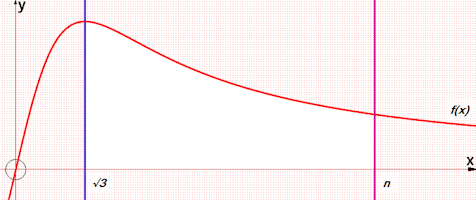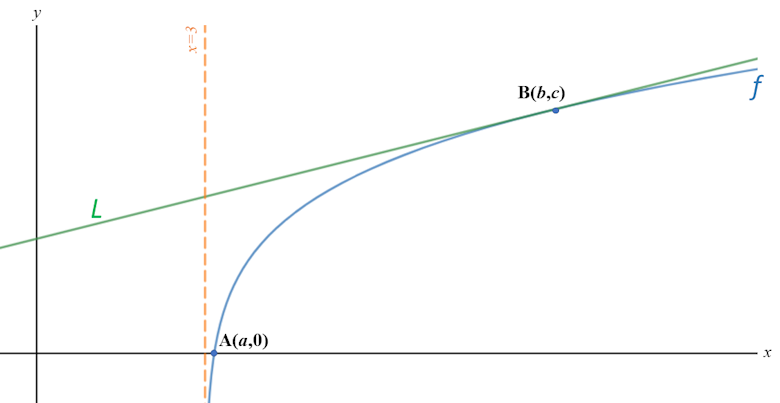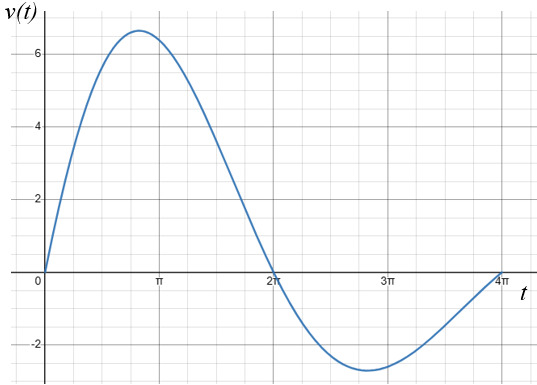
 |
Exam-Style Questions.Problems adapted from questions set for previous Mathematics exams. |
1. | IB Standard |
Let \(f(x)=\frac{2x}{x^2+3}\)
(a) Use the quotient rule to show that \(f'(x)=\frac{6-2x^2}{(x^2+3)^2}\).
(b) Find \(\int \frac{2x}{x^2+3}dx\).

(c) The area enclosed by the graph of \(f(x)\), the x-axis and the lines \(x=\sqrt3\) and \(x=n\) has an area of \(\ln14\). Find the value of \(n\).
2. | IB Standard |
Very accurate equipment was used to measure the movement of a particle which moved in a straight line for 3 seconds. Its velocity, \(v\) ms-1 , at time \(t\) seconds, is given by:
$$v=(t^2-5)^3$$(a) Find the velocity of the particle when \(t=2\).
(b) Find the value of t for which the particle is at rest.
(c) Find the total distance the particle travels during the first three seconds.
(d) Show that the acceleration of the particle is given by \(a=6t(t^2-5)^2\)
(e) Find all possible values of t for which the velocity and acceleration are both positive or both negative.
3. | IB Analysis and Approaches |
Consider the function \(f\) defined by \(f(x)= \ln{(x^2 - 9)}\) for \(x > 3\).
The following diagram shows part of the graph of \(f\) which crosses the x-axis at point \(A\) with coordinates \((a,0)\).
The line \(L\) is the tangent to the graph of \(f\) at the point \(B\) with coordinates \((b,c)\). The gradient of \(L\) is \( \frac14\)

(a) Find the exact value of \(a\).
(b) Find the value of \(b\).
4. | IB Standard |
If \(f(x)=x\sin{x}\), for \(-3\le x\le3\)
(a) Find \(f'(x)\)
(b) Sketch the graph of \(y=f'(x)\), for \(-3\le x\le3\)
5. | IB Analysis and Approaches |
A particle moves in a straight line such that its velocity, \(v\) ms-1, at time \(t\) seconds is given by:
$$ v(t)=10e^{-\frac{t}{7}} \sin\left(\frac{t}{2}\right) $$for \( 0 \le t \le 4 \pi\). The graph of \(v\) is shown in the following diagram.

Let \(t_1 \) be the first time when the particle's acceleration is zero.
(a) Find the value of \(t_1\).
(b) Find the distance travelled by the particle between \(t = t_1 \), and t = \(4 \pi \).6. | IB Standard |
Let \(f(x)=\frac{g(x)}{h(x)}\), where \(g(3)=36\), \(h(3)=12\), \(g'(3)=10\) and \(h'(3)=4\). Find the equation of the normal to the graph of \(f\) at \(x=3\).
7. | IB Analysis and Approaches |
The displacement, in millimetres, of a particle from an origin, O, at time t seconds, is given by \(s(t) = t^3 cos t + 5t sin t\) where \( 0 \le t \le 5 \) .
(a) Find the maximum distance of the particle from O.
(b) Find the acceleration of the particle at the instant it first changes direction.
8. | IB Analysis and Approaches |
The edge lengths, \(x\) cm, of a cube are increasing at a rate of 6 cm s-1.
Find the rate at which the volume of the cube, \(V\) cm3, is increasing when the edge lengths are 20cm.
9. | IB Standard |
The function \(f\) is defined as follows:
$$f(x)=\frac{122}{1+60e^{-0.3x}}$$(a) Calculate \(f(0)\).
(b) Find a value of \(x\) for which \(f(x)=85\)
(c) Find the range of \(f\).
(d) Show that:
$$f'(x)=\frac{2196e^{-0.3x}}{(1+60e^{-0.3x})^2}$$(e) Find the maximum rate of change of \(f\).
10. | IB Standard |
Make a sketch of a graph showing the velocity (in \(ms^{-1}\)) against time of a particle travelling for six seconds according to the equation:
$$v=e^{\sin t}-1$$(a) Find the point at which the graph crosses the \(t\) axis.
(b) How far does the particle travel during these first six seconds?
11. | IB Analysis and Approaches |
The function \(f\) is such that \(f(x) = \frac{\ln2x}{x^3} \) where \(x \gt 0\).
(a) Find the first derivative of the function, \( f'(x) \).
(b) The graph of \( y=f(x) \) has a horizontal tangent at the point T. Find the coordinates of T.
(c) Show that T is a local maximum point by considering the second derivative, \( f''(x) \).
(d) Find the values of \(x\) for which \( f(x) \gt 0 \).
(e) Sketch the graph of \( f \) showing clearly the value of the x-intercept and the approximate position of point T.
12. | IB Analysis and Approaches |
Let \(f(x) = \frac{ln3x}{kx} \) where \( x \gt 0\) and \( k \in \mathbf Q^+ \).
(a) Find an expression for the first derivative \(f'(x) \).
The graph of \(f\) has exactly one maximum point at P.
(b) Find the x-coordinate of P.
The graph of \(f\) has exactly one point of inflection at Q.
(c) Find the x-coordinate of Q.
(d) The region enclosed by the graph of \(f\), the x-axis, and the vertical lines through P and Q has an area of one square unit, find the value of \(k\).
If you would like space on the right of the question to write out the solution try this Thinning Feature. It will collapse the text into the left half of your screen but large diagrams will remain unchanged.
The exam-style questions appearing on this site are based on those set in previous examinations (or sample assessment papers for future examinations) by the major examination boards. The wording, diagrams and figures used in these questions have been changed from the originals so that students can have fresh, relevant problem solving practice even if they have previously worked through the related exam paper.
The solutions to the questions on this website are only available to those who have a Transum Subscription.
Exam-Style Questions Main Page
To search the entire Transum website use the search box in the grey area below.
Do you have any comments about these exam-style questions? It is always useful to receive feedback and helps make this free resource even more useful for those learning Mathematics anywhere in the world. Click here to enter your comments.